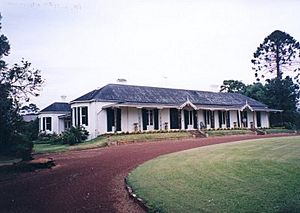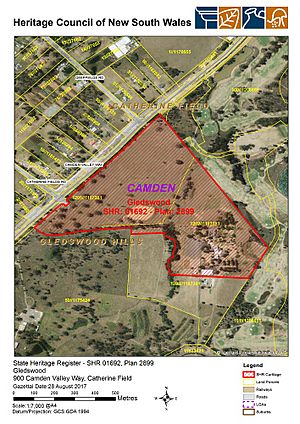Gledswood facts for kids
Quick facts for kids Gledswood |
|
|---|---|
 |
|
| Location | 900 Camden Valley Way, Gledswood Hills, Camden Council, New South Wales, Australia |
| Built | 1827–1855 |
| Owner | Caldla Pty Ltd; Sekisui House Australia Pty Ltd; Sekisui House Australia Pty Ltd |
| Official name: Gledswood; Buckingham | |
| Type | State heritage (landscape) |
| Designated | 22 December 2006 |
| Reference no. | 1692 |
| Type | Homestead Complex |
| Category | Farming and Grazing |
| Builders | James Chisholm |
| Lua error in Module:Location_map at line 420: attempt to index field 'wikibase' (a nil value). | |
Gledswood is a special historic place in Gledswood Hills, New South Wales, Australia. It used to be a large farm with vineyards and a homestead. Today, it's a place where people can visit, play golf, and some parts are private homes.
The main house and other buildings were constructed between 1827 and 1855. A man named James Chisholm built much of it. This property is also known as Buckingham. It is privately owned and was added to the New South Wales State Heritage Register on 22 December 2006 because of its important history.
Contents
The Story of Gledswood
Early Days and First Owners
The story of Gledswood began with Gabriel Louis Marie Huon de Kerilleau. He came to Sydney in 1794 from France. He was a private soldier in the New South Wales Corps.
After leaving the army in 1807, he became a teacher. He taught the sons of John Macarthur, a very important person in early Australian history.
In 1810, Governor Macquarie gave Gabriel Louis 162 hectares (400 acres) of land. He named this land 'Buckingham'. He named it after the Marquis of Buckingham, who helped him leave the army.
Gabriel Louis used convicts to help him build on the property. They first built a small cottage. Then they built a coach house and servants' quarters.
James Chisholm Takes Over
In 1816, Gabriel Louis sold the property to James Chisholm for 250 pounds. Gabriel Louis then moved to a new property.
James Chisholm renamed the property "Gledswood". Around 1827, he finished building the main homestead. James Chisholm was friends with John Macarthur. They both were interested in growing grapes for wine.
In 1830, James Chisholm's son, James II, planted a vineyard. In 1847, two German vine dressers, Frederick and Anna Worner, came to work on the vineyard. The Chisholms were very proud of their vines.
The main house had a large cellar built by convicts. This cellar could hold 20,000 bottles of wine! The Chisholm family owned Gledswood for 90 years.
Growing the Farm and Garden
By 1850, Gledswood had grown to 400 hectares (1000 acres). Besides grapes, they also raised cattle and sheep. Their wool was known for being very good.
The farm had its own butcher shop and a large fruit orchard. They also had cows for milk and cream. James Chisholm planted the estate's famous garden. His son, James II, made the gardens even better.
Around the 1870s, Gledswood was updated. Its amazing garden was even written about in a magazine in 1870. The garden was a very important part of Gledswood.
Gledswood Today
In 1971, the Testoni brothers bought Gledswood. They promised to restart the winery. They planted 60 hectares (148 acres) of grapes. They also had a small herd of cattle to make cheese.
Over the years, parts of the Gledswood land were sold off. Today, Gledswood is run by the Testoni family as a tourist farm. Visitors can see what a colonial farm was like. They can also taste wine, have weddings, and eat at the country restaurant. The main house is used for events.
What Gledswood Looks Like
The Farm and Homestead
Gledswood is located on 65 hectares (160 acres) of farmland. It is visible when you travel along Camden Valley Way.
The main house was built around 1830 by James Chisholm. It was later updated in the 1870s. It has a long stone verandah on the front. The house has special features like decorative wooden trim and French doors with small windows above them. The walls are made of brick covered in a smooth finish.
The driveway to Gledswood winds through open fields. You can see old trees that frame the view of the homestead. There are also tall hoop pines (Araucaria cunninghamii) that help you spot the house from far away. These old trees are a key part of the 19th-century look of the landscape.
Other Buildings
The kitchen building is separate from the main house, creating a courtyard. Other buildings on the property include:
- Large cellars (underground rooms for storage)
- An office building
- A two-story stable building, which is now used as a restaurant
- A machinery shed
- A decorative wooden hen house
The Gardens
Gledswood has a beautiful and unique garden. It has a large formal garden area and many plants typical of the 19th century. These gardens create interesting spaces with views of the countryside. The tall Bunya pines are a famous landmark at Gledswood.
Close to the house, there is a well-kept lawn and formal garden. There are also areas of bushland. A group of pepper trees stands near the administration building. Some of these trees might be from the mid to late 1800s. There is also an old Moreton Bay Fig tree.
The front of the homestead has a large oval-shaped gravel driveway. There is also a single large white cedar tree near the driveway. The garden on the eastern side of the house has a mix of different trees and shrubs. This mix was popular in the late 19th and early 20th centuries. There is also a rose garden and other plants like jacaranda trees. An old macadamia nut tree is a rare sight in this area.
Gledswood's Condition and Changes
Gledswood has mostly kept its original design. This means it could offer clues about early European farming and gardening. While some buildings have been used for new purposes, the overall design remains similar.
Over the years, the size of the Gledswood estate has changed:
- 1810: Gabriel Louis received 162 hectares (400 acres).
- 1815-1818: James Chisholm acquired more land, expanding the property.
- Around 1870s: Major updates were made to the Gledswood homestead. Gothic-style verandahs and porches were added. The gardens were also expanded.
- 1881-1888: Land was used for building The Upper Canal, a water supply for Sydney. Bridges were built over the canal for access.
- 1959: Gledswood was divided into three parts.
- 1971: The Testoni brothers bought Gledswood. They aimed to bring back the vineyards and make it a tourist spot.
- 1972-1978: Several parts of the estate were sold off or transferred. For example, over 400 hectares (1000 acres) were separated for the El Caballo Blanco horse show business.
- 1970s: More subdivisions of the eastern parts of the property occurred.
Today, buildings like the two-story stables are used as a restaurant.
Why Gledswood is a Heritage Site
Gledswood is an important historic farm from the early 1800s. It is closely linked to the Camden area, where Australia's wool industry began. James Chisholm built Gledswood around 1830, and his family lived there for 90 years.
One of the most special things about Gledswood is its amazing colonial garden. This garden was expanded in 1870 and was even featured in a magazine. The strong interest in gardening at Gledswood made it a big part of gardening history in New South Wales.
Gledswood is also important for its role in Australia's early wine industry. James Chisholm junior planted a vineyard in 1830. German vine dressers were brought in to work there in 1847. The convict-built cellar under the house could hold 20,000 bottles of wine.
Gledswood was added to the New South Wales State Heritage Register on 22 December 2006 for several reasons:
- It shows the history of New South Wales: Gledswood was built in the 1830s and updated in the 1870s. It shows how colonial-style designs changed over time.
- It is linked to important people: Gledswood stayed in the Chisholm family for 90 years. Its famous garden was mentioned in magazines and by famous artists.
- It is beautiful and well-designed: Gledswood has one of the best gardens in the Cowpastures area. It was even described as "romantic" by an artist.
- It is important to the community: Gledswood has a strong connection to the Camden area. Its well-kept colonial gardens and buildings show a unique historic rural character.
- It can teach us about the past: Gledswood has the potential to provide information about early colonial settlement. This can help us understand our cultural history better.
- It is a rare example: Gledswood is a rare example of an early Australian homestead. It has gardens and ornamental plants from the mid-1800s.
- It represents a type of place: Gledswood shows what early colonial farms in the Cowpastures area were like. Its gardens show how European garden styles influenced Australia.
See also
- Australian residential architectural styles


